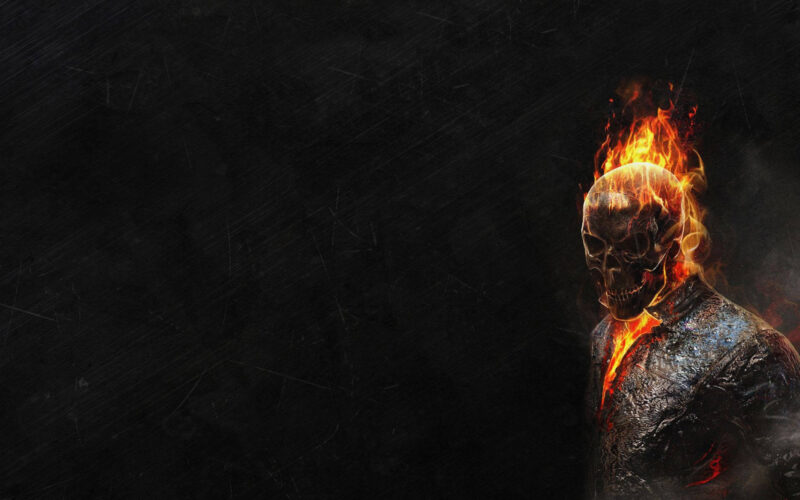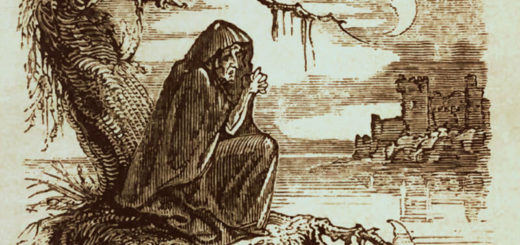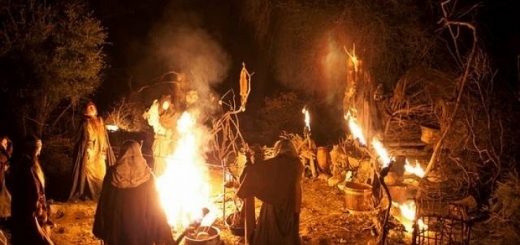Feurige Männer – Burning ghosts in German and Alpine folklore
Especially in South Germany, Austria, and Switzerland, there is a unique type of phantom known as “Feurige Männer,” “Feurputzen,” or “Feurmänner.” These entities are typically the spirits of men who, during their lifetimes, disregarded the boundaries of their neighbors’ fields by relocating border stones or engaging in other actions. As a consequence, they are condemned to wander the border zones or the areas to which their transgressions were attached. These spectral figures manifest as terrifying burning men or as a burning skeleton.

Feurige Männer
In Bavarian folklore, the Feurige Männer (Fiery Men), also known as Landsknechte, are ghostly beings. They appear human and are dressed accordingly, but fire emanates from their mouths. Their backs are hollowed like cavities from which fire bursts forth. They serve as guides, lighting the way for people returning home. The Feurige Männer are souls condemned to suffer because, in life, they disturbed the boundaries of their neighbors’ fields by moving boundary stones. As a penance, they often have to carry these stones, constantly asking, “Wou dou i den hi?” (Where do I put it?) Redemption comes when someone replies, “Dahin, wo du ihn genommen hast” (To where you took it). In the past, sightings of Feurige Männer were common, and every peasant likely encountered one at least once. They were not fearsome unless offended. For a small fee, they would light up homes and escort people to their front doors. However, failing to fulfill promises could lead to the spirit leading a person away through the air or setting their house on fire. When a Fiery Man approaches, running away is not advised, as they may sit on one’s back and lead them astray. Offending them with the term “Geltenscheisser” prompts vengeance through Aufhugeln (lifting up) and seduction.
An Austrian Story
In former times, fiery figures often appeared to fishermen on the Salzach River near Laufen, below Salzburg, during “Lässel” or “Losnächte.” Starting as small as candlelight, resembling Will-o’-the-Wisps, they gradually grew into giants before shrinking and disappearing. This tale is preserved in Salzburger Volkssagen, Vol. 2, Vienna/Pest/Leipzig, 1880, by R. von Freisauff.
Feuerputz or Feuermann
The Feuerputz, also called Brünnling, Feurputz, Glühender, Züsler, but most commonly Feuermann, is a fiery phantom. While it can take various forms, it is predominantly described as anthropomorphic. Common guises include a burning, glowing skeleton, a black man in a pillar of fire, a fiery horseman, a burning plowman, or a fireball (bright meteor). The Sächsische Weltchronik mentions guards seeing such a fireball travel between two castles in 1120. Renward Cysat, a Lucerne historian, encountered a Fire Man, describing Züsler in Switzerland as skeletons with flames leaking through their bones and eye sockets. Feuermänner are souls purging sins after death, their fiery appearance being their purgatory. Their sins vary, but they often involve dishonest practices, such as fraudulent orphan guardianship, forging documents, perjury, and other offenses. Redemption for Feuermänner can be achieved through friendly behavior and illumination of the way for people. A simple “Vergelt’s Gott” (God’s retribution) is believed to be sufficient for their redemption, according to Cysat.
You may also like to read:
Drekavac the baby phantom of Serbo-Croation folklore
Dokkaebi, the Goblins of Korean Folklore
Water Spirits of Eastern Europe
Brook horses or Water horses of Celtic and Nordic Folklore






